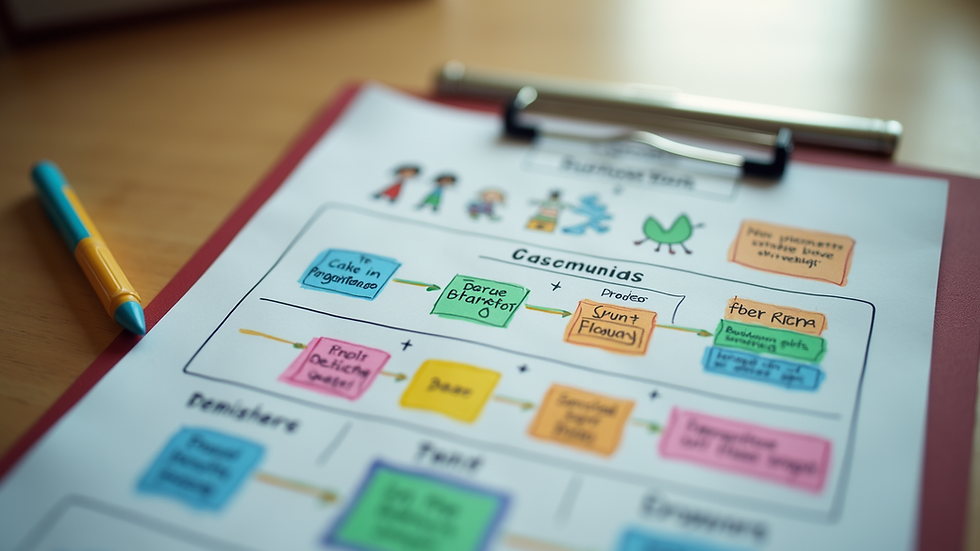Crafting Effective Behavioral Intervention Plans for Children
- Sarah Eis
- Oct 23
- 4 min read
When we think about supporting children with diverse developmental and behavioral needs, one of the most powerful tools we can use is a well-crafted child behavior plan. These plans help us understand the unique challenges a child faces and provide a clear path to encourage positive growth. Together, we can create nurturing environments where children feel safe, understood, and empowered to thrive.
Understanding the Importance of Child Behavior Plans
Child behavior plans are more than just documents - they are personalized roadmaps designed to guide us in supporting a child's emotional and behavioral development. These plans help identify specific behaviors that may be challenging and outline strategies to address them in a compassionate and effective way.
For example, if a child struggles with frequent outbursts in the classroom, a behavior plan might include calming techniques, scheduled breaks, or positive reinforcement for moments of calm. By focusing on clear, achievable goals, we can celebrate small victories that build confidence and resilience.
Key elements of a successful child behavior plan include:
Clear identification of target behaviors
Understanding the reasons behind these behaviors
Practical strategies for intervention
Consistent monitoring and adjustment
Collaboration among caregivers, educators, and specialists
By working together, we create a supportive network that encourages positive change and helps children feel valued and understood.

How to Develop Child Behavior Plans That Work
Creating an effective child behavior plan requires patience, observation, and teamwork. Here’s a step-by-step approach that we can follow to ensure the plan truly meets the child’s needs:
Gather Information
Start by observing the child in different settings. Note when and where challenging behaviors occur, what seems to trigger them, and how the child responds to various interventions.
Define Clear Goals
Set specific, measurable, and realistic goals. For instance, instead of saying "reduce tantrums," aim for "reduce tantrums from five times a day to two times a day within one month."
Choose Positive Strategies
Focus on teaching new skills rather than just stopping unwanted behaviors. This might include teaching communication skills, coping mechanisms, or social interactions.
Involve Everyone
Make sure parents, teachers, and therapists are all on the same page. Consistency across environments is key to success.
Monitor Progress and Adjust
Regularly review the plan’s effectiveness. Celebrate successes and be ready to tweak strategies if something isn’t working.
By following these steps, we create a living document that grows with the child and adapts to their evolving needs.

What is the difference between IEP and behavioral intervention plan?
It’s important to understand how child behavior plans fit within the broader framework of educational support. Two common tools are the Individualized Education Program (IEP) and the behavioral intervention plan.
An IEP is a comprehensive document developed for children who qualify for special education services. It outlines educational goals, accommodations, and services tailored to the child’s learning needs.
A behavioral intervention plan, on the other hand, focuses specifically on addressing challenging behaviors that interfere with learning or social interaction. It is often part of the IEP but can also stand alone when behavior is the primary concern.
While the IEP covers academic and developmental goals, the behavioral intervention plan zeroes in on understanding and changing specific behaviors through targeted strategies.
Understanding this distinction helps us advocate effectively and ensures that children receive the right support in all areas of their development.
Practical Tips for Implementing Behavior Plans at Home and School
Implementing a child behavior plan consistently across home and school environments can feel overwhelming, but with a few practical tips, we can make this process smoother and more effective.
Create Visual Supports
Use charts, schedules, or picture cues to remind the child of expectations and routines. Visuals can reduce anxiety and increase understanding.
Use Positive Reinforcement
Celebrate successes with praise, rewards, or special activities. Positive reinforcement encourages repetition of good behavior.
Stay Calm and Patient
Children often mirror our emotions. Responding with calmness and empathy helps de-escalate challenging moments.
Communicate Regularly
Keep open lines of communication between home and school. Share observations and progress to maintain consistency.
Be Flexible
Sometimes strategies need adjustment. If something isn’t working, don’t hesitate to try a new approach.
By integrating these tips, we create a nurturing environment that supports the child’s growth and helps them feel secure and understood.
How We Can Support Each Other on This Journey
Navigating the world of child behavior plans can feel daunting, but remember, you are not alone. There are many resources and professionals ready to help guide us through this process. For example, behavioral intervention plans offered by specialists can provide tailored support and expert guidance.
Together, we can build a community of understanding and encouragement. Sharing experiences, asking questions, and seeking support empowers us to advocate confidently for the children we care about.
Every step we take toward understanding and supporting a child’s unique needs is a step toward a brighter, more hopeful future.
By embracing these strategies and resources, we open the door to meaningful progress and joyful growth. Let’s continue to nurture, support, and celebrate every child’s journey.




Comments